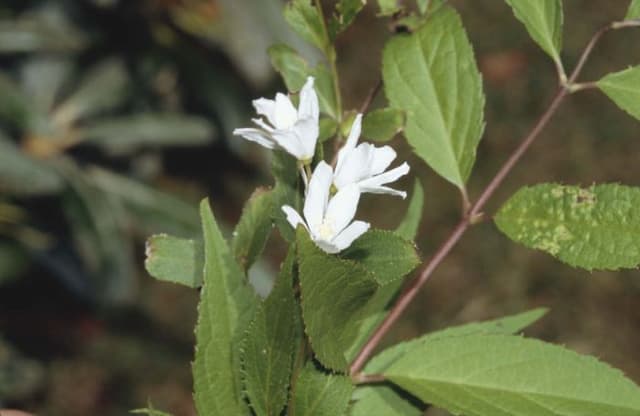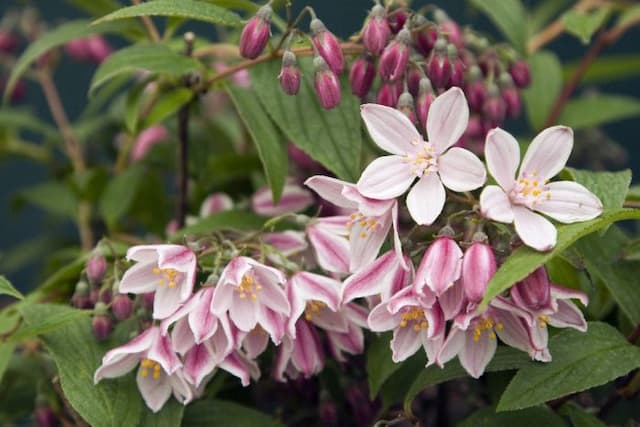Panicle Hydrangea Hydrangea paniculata 'Chantilly Lace'

ABOUT
The Hydrangea paniculata 'Chantilly Lace' is a stunning flowering shrub well-known for its distinctive and showy blooms. Its flowers present themselves in large, cone-shaped clusters, typically during the summer months. The blossoms at the base of the clusters are larger, sporting a creamy white color that can transition to blush pink or even a light green tint as they age. The smaller flowers in the cluster add a delicate texture to the overall floral display, contributing to the lacey effect that likely inspired the plant's namesake. The leaves of 'Chantilly Lace' are broadly ovate, with pointed tips and serrated edges. The foliage provides a lush green backdrop which beautifully contrasts the bright white flower clusters. With each passing season, the leaves may turn to shades of yellow or red before falling off, adding another layer of visual interest to this lovely shrub. Overall, 'Chantilly Lace' offers a romantic and airy appearance, making it a popular choice for gardens where a visual impact is desired without the need for an imposing stature.
About this plant
 Names
NamesFamily
Hydrangeaceae
Synonyms
Panicle Hydrangea, Peegee Hydrangea
Common names
Hydrangea paniculata.
 Toxicity
ToxicityTo humans
The common name for Hydrangea paniculata 'Chantilly Lace' is Hydrangea. Hydrangeas are considered to have low toxicity to humans. However, if ingested, they can cause mild symptoms due to the presence of cyanogenic glycosides in the plant's leaves and flowers. Symptoms of poisoning can include stomach upset, nausea, vomiting, and diarrhea. Eating large quantities may lead to more severe symptoms.
To pets
Hydrangea, which refers to Hydrangea paniculata 'Chantilly Lace', is toxic to pets such as cats and dogs. Pets that consume Hydrangea can suffer from symptoms of poisoning as a result of cyanogenic glycosides found in the plant. These symptoms include gastrointestinal upset, vomiting, diarrhea, and lethargy. Ingesting large amounts of the plant can lead to more serious issues such as depression or confusion due to the cyanide's effect on oxygen distribution in the body.
 Characteristics
CharacteristicsLife cycle
Perennials
Foliage type
Deciduous
Color of leaves
Green
Flower color
White
Height
6-8 feet (1.8-2.4 meters)
Spread
6-8 feet (1.8-2.4 meters)
Plant type
Shrub
Hardiness zones
3-8
Native area
Asia
Benefits
 General Benefits
General Benefits- Ornamental Appeal: Panicle hydrangea 'Chantilly Lace' has large, showy flowers that add visual interest to gardens and landscapes.
- Seasonal Interest: This plant offers a long blooming season, typically from mid-summer to fall, providing color when many other plants have finished flowering.
- Low Maintenance: Once established, it requires minimal care, making it suitable for gardeners of all skill levels.
- Drought Tolerance: The hydrangea is relatively drought-tolerant, making it a good choice for gardens with limited water availability.
- Cold Hardy: It is capable of withstanding colder temperatures, which makes it suitable for planting in a variety of climates and USDA hardiness zones.
- Attracts Pollinators: The flowers attract bees and butterflies, which are beneficial for pollination of gardens and the environment.
- Versatility in Landscaping: It can be planted in borders, as a specimen plant, or in mass plantings, offering flexibility in garden design.
 Medical Properties
Medical PropertiesThis plant is not used for medical purposes.
 Air-purifying Qualities
Air-purifying QualitiesThis plant is not specifically known for air purifying qualities.
 Other Uses
Other Uses- Photography Prop: Hydrangea paniculata 'Chantilly Lace' provides a visually pleasing backdrop for portraits and macro photography due to its large, intricate blooms.
- Frost Resistant Garden Display: This plant's ability to withstand a light frost can extend the visual appeal of a garden into the fall season.
- Theme Gardens: 'Chantilly Lace' can be used to create a consistent color theme in a white garden, where various shades of white flowers and foliage provide a monochromatic display.
- Natural Screening: When planted closely together, the Hydrangea paniculata 'Chantilly Lace' can act as a privacy screen, obscuring unsightly views or separating garden areas.
- Flower Arranging Classes: The long-lasting flowers and sturdy stems of 'Chantilly Lace' make it ideal for use in teaching flower arrangement and bouquet design.
- Educational Plant Studies: Schools and universities can use this cultivar to teach students about plant breeding, cultivation, and horticultural practices.
- Art Inspiration: The delicate lace-cap flowers can serve as a subject for botanical illustration or inspire patterns in designs such as fabric, wallpaper, or other decorative arts.
- Textile Dyeing: Though not a traditional use, the naturally occurring pigments in the flowers could potentially be explored for use in textile dyeing.
- Cultural Festivals: In places where hydrangeas have cultural significance, such as Japan's "Ajisai Matsuri" (Hydrangea Festival), 'Chantilly Lace' can be showcased.
- Culinary Garnish: While not for consumption, the blooms can be used as a non-toxic decorative garnish for elegant dish presentations at upscale dining events.
Interesting Facts
 Feng Shui
Feng ShuiThe Hydrangea is not used in Feng Shui practice.
 Zodiac Sign Compitability
Zodiac Sign CompitabilityThe Hydrangea is not used in astrology practice.
 Plant Symbolism
Plant Symbolism- Heartfelt Emotions: Hydrangeas are often associated with the expression of deep feelings and heartfelt emotions, such as gratitude for being understood or for deeper understanding between people.
- Gratitude: Giving hydrangeas can symbolize thanks and appreciation. 'Chantilly Lace', with its delicate flowers, can represent sincere acknowledgments of kindness.
- Apology: In some contexts, hydrangeas can be given as an apology, symbolizing remorse and a wish for reconciliation.
- Vanity or Frivolity: Historically, hydrangeas have sometimes been linked to vanity or boastfulness because of their showy and abundant blooms.
- Abundance: The full, lush clusters of the hydrangea blooms can represent abundance and prosperity, making them appropriate for celebratory occasions.
- Perseverance: Hydrangeas are hardy plants that can adapt to different climates and soils. 'Chantilly Lace', like other hydrangeas, can symbolize perseverance and the ability to endure challenging situations.
 Water
WaterPanicle hydrangeas, including 'Chantilly Lace', prefer consistently moist soil, so water them deeply about once a week, providing about one inch of water each time. During particularly hot or dry periods, you may need to water twice a week. Avoid overhead watering to prevent leaf diseases; instead, water at the base of the plant. In total, aim for about one gallon per week under normal conditions, but adjust as necessary based on weather and soil drainage.
 Light
LightPanicle hydrangeas like 'Chantilly Lace' thrive in full sun to partial shade. They perform best with at least four hours of direct sunlight each day, preferably in the morning, with some afternoon shade to protect from intense heat. An ideal spot is one that gets bright morning light and dappled sunlight in the afternoon.
 Temperature
TemperaturePanicle hydrangeas like 'Chantilly Lace' can tolerate a wide temperature range, from about -30 to 95 degrees Fahrenheit. They are hardy in USDA zones 3 to 8 and prefer a more moderate climate with temperatures generally between 65 and 75 degrees Fahrenheit. They may need protection from late spring frosts or extreme winter cold.
 Pruning
PruningPrune panicle hydrangeas like 'Chantilly Lace' in late winter or early spring before new growth starts to remove dead wood and shape the plant. As they bloom on new wood, annual pruning encourages fresh growth and larger blooms. Prune about one-third of the oldest stems to ground level to promote vigor and blooming.
 Cleaning
CleaningAs needed
 Soil
SoilFor the Peegee Hydrangea, create a soil mix with good drainage, consisting of 50% loam, 30% compost, and 20% perlite or vermiculite. They prefer a soil pH of around 5.5 to 6.5.
 Repotting
RepottingPeegee Hydrangeas typically require repotting every 3 to 5 years, depending on their growth rate and the size of the container they are in.
 Humidity & Misting
Humidity & MistingPeegee Hydrangeas thrive at average outdoor humidity levels, around 40-60%. They do not require any special humidity considerations.
 Suitable locations
Suitable locationsIndoor
Place in bright, indirect light and monitor moisture.
Outdoor
Plant in partial sun, sheltered from strong winds.
Hardiness zone
3-8 USDA
 Life cycle
Life cycleThe Hydrangea paniculata 'Chantilly Lace', commonly known as PeeGee Hydrangea, begins its life cycle as a dormant, bare-root plant or as a potted nursery plant. In the spring, it breaks dormancy by sprouting new growth from its woody stems. As the plant matures through spring into summer, it develops large, panicle-shaped clusters of white flowers that can take on shades of pink or red as they age. Throughout the growing season, it undergoes vegetative growth, expanding both its root system and foliage. In the fall, the PeeGee Hydrangea enters a period of senescence, where the leaves turn yellow and drop off, and the plant prepares to go dormant for the winter. Finally, it overwinters in dormancy, with the cycle repeating the following spring.
 Propogation
PropogationPropogation time
Late winter
The most popular method for propagating the Hydrangea paniculata 'Chantilly Lace', commonly known as panicled hydrangea, is via softwood cuttings. This is typically done in late spring to early summer when the new growth is still tender and flexible. A cutting of about 5 to 6 inches (approximately 12.7 to 15.2 cm) long, with several leaves, is taken from a healthy, disease-free mother plant. The lower leaves are removed, and the cut end is dipped into rooting hormone to encourage root development. Then, the cutting is planted in a well-draining soil mix, ensuring at least two sets of nodes are beneath the soil surface. It is important to keep the soil consistently moist and to place the cutting in indirect light until roots have developed, which usually takes 4 to 6 weeks. After rooting, the new plant can be transferred to a larger pot or directly into the garden.








![Hydrangea [Strong Annabelle]](/_next/image?url=https%3A%2F%2Fplants-admin.emdemapps.com%2Fimages%2Fplants%2F%2Fimages%2F604b54db37d34.png&w=640&q=75)
